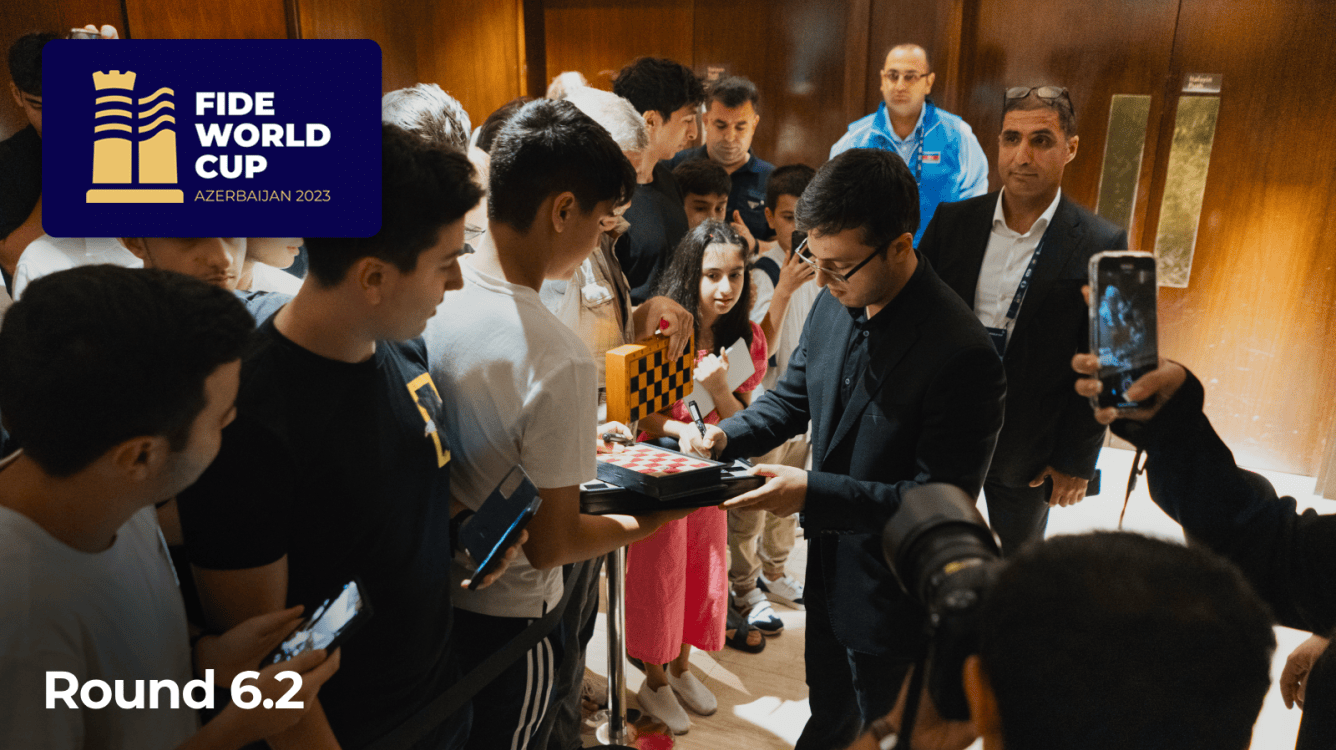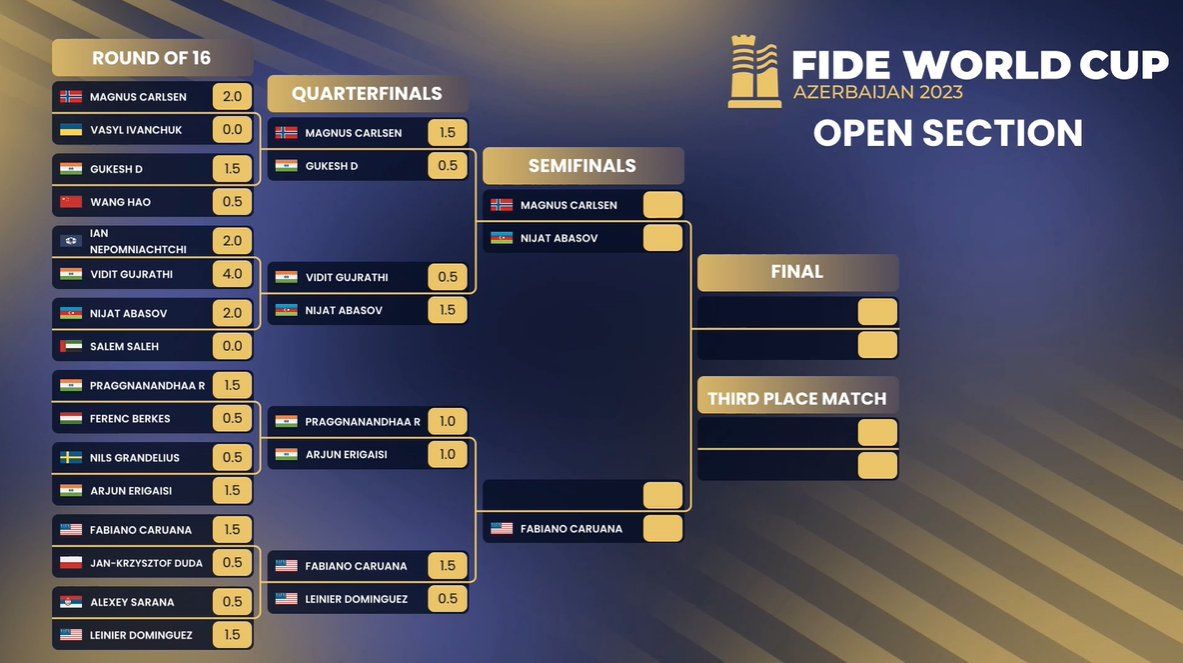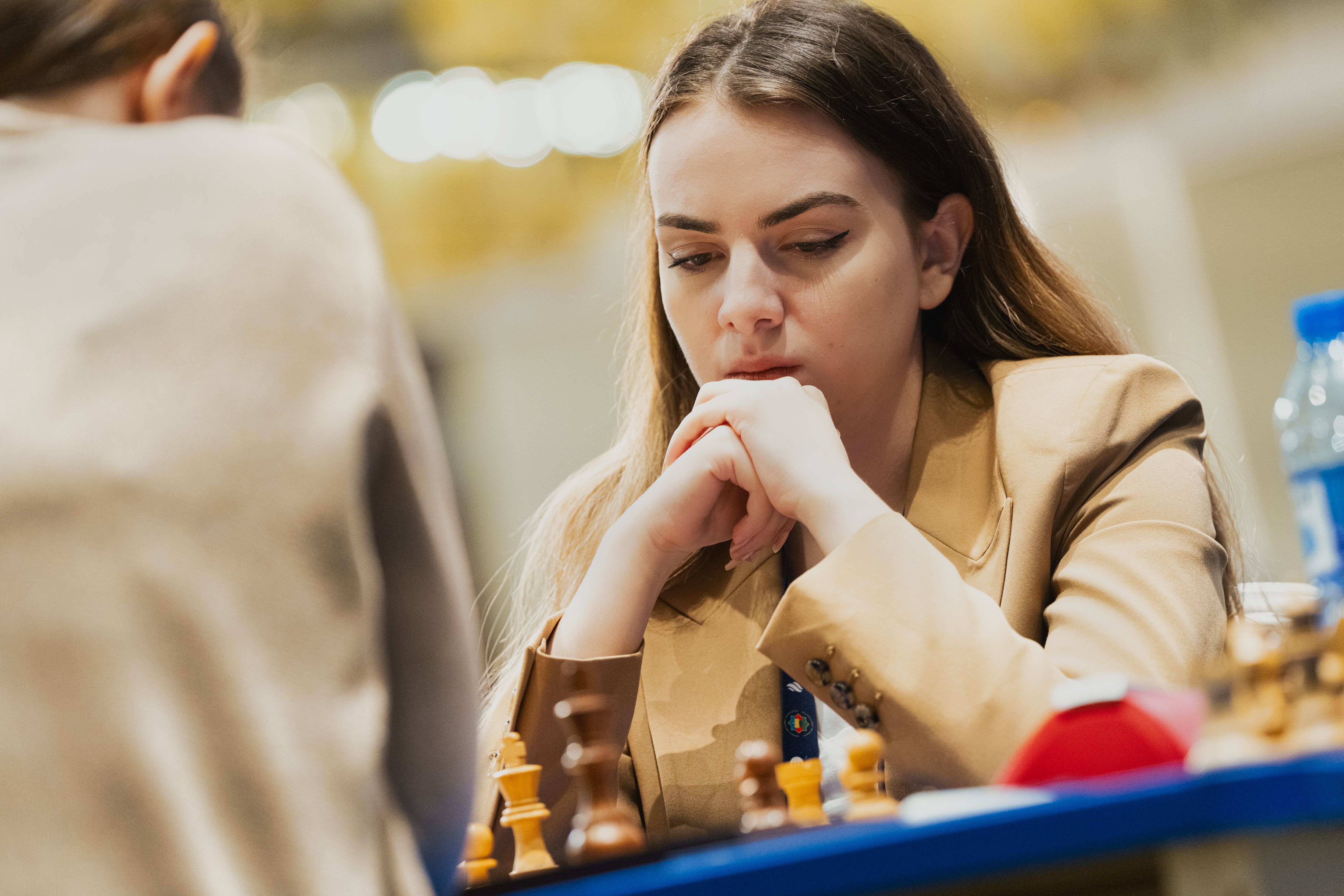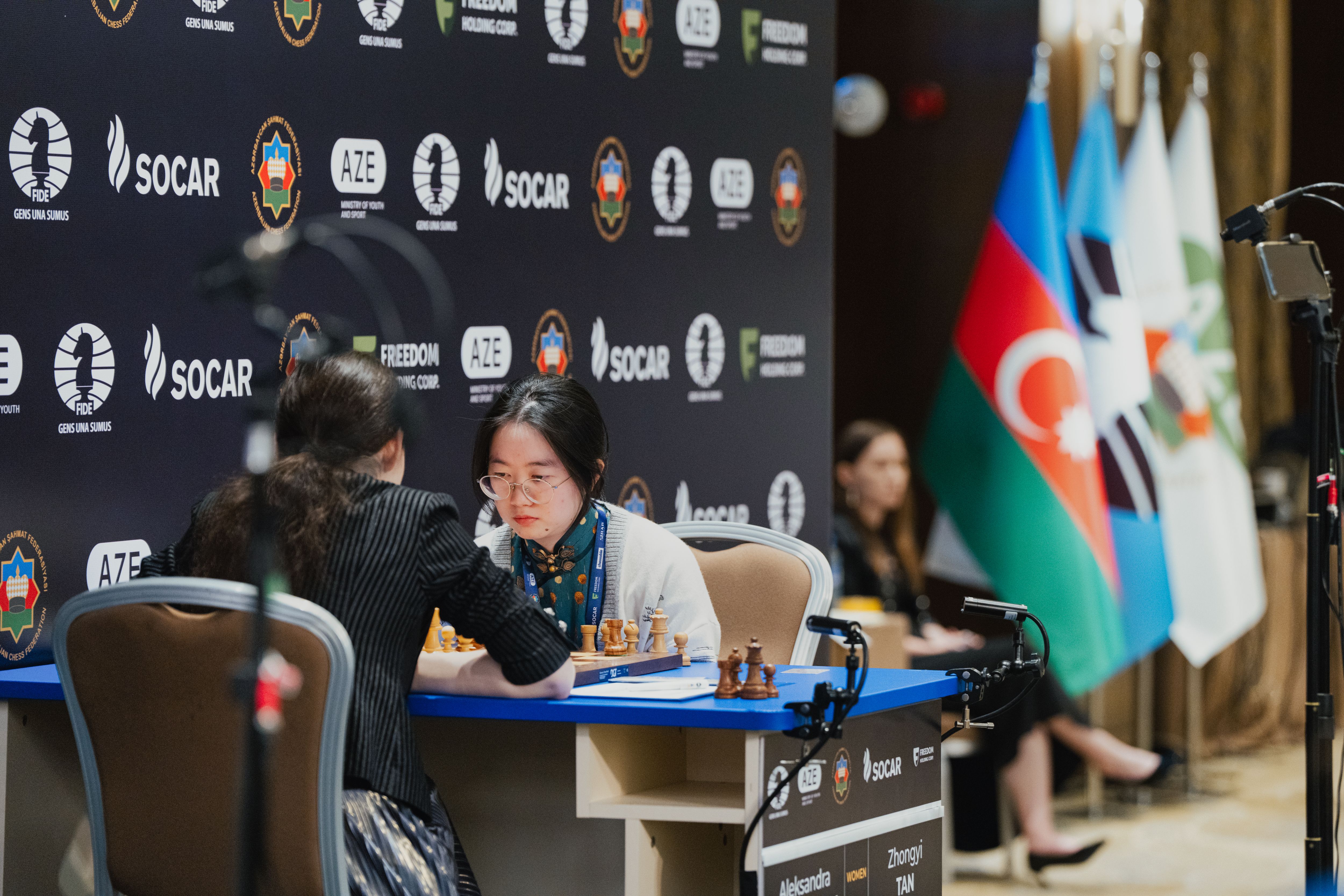
Abasov Continues Miracle Run On Home Soil To Join Carlsen, Caruana In Semifinals
GM Magnus Carlsen staved off a formidable challenge from GM Dommaraju Gukesh and held the draw he needed, while GM Nijat Abasov and GM Fabiano Caruana defeated GM Vidit Gujrathi and GM Leinier Dominguez, respectively, to advance to the semifinals of the 2023 FIDE World Cup Open section. GM Praggnanandhaa Rameshbabu fought hard and scored a crucial win with the black pieces against GM Arjun Erigaisi to force a tiebreak to decide the last semifinalist.
Carlsen later appeared on the live commentary channel and confirmed that all the other semifinalists of this world cup will have a place in the 2024 Candidates Tournament, in view of his avowed non-participation in the event.
GM Aleksandra Goryachkina appeared to play steadily to force the required draw against GM Tan Zhongyi to reach the finals of In the 2023 FIDE Women's World Cup. IM Nurgyul Salimova and GM Anna Muzychuk were involved in a fairly level game ending in a draw, thus moving on to the tiebreak to decide the second finalist.
The tiebreaks games of round six will begin Thursday, August 17, at 7 a.m. ET / 13:00 CEST / 4:30 p.m IST.
As the second game of round six started, commentator Howell came up with an interesting statistic about the event overall: "So far [in] this tournament, Black has won only 20% of the games." This was not an encouraging statistic considering that Gukesh, Praggnanandhaa, and Tan had to win on demand with the black pieces on the day, having lost with the white pieces in the first game. An added detail could be the strength of their opponents.
Analyzing Tan's situation, commentator Leko came up with a game plan for playing with the black pieces: "If Black gets some kind of double-edged complex middlegame, and can play a long game, you never know what happens." A clear-cut but daunting task for players with the black pieces facing elimination in case of a draw.
But after intense, fighting chess on almost all the boards approaching the fourth hour of play, things developed dramatically, as all the black players requiring a win seemed to be fighting their best, providing the fans with a great day of intense chess.
Open Section
Requiring only a draw with the white pieces, Carlsen made clear his intentions for the day against Arjun by choosing the Alapin variation against the Sicilian defense, making Leko observe with amusement, "The c3 Sicilian: very annoying setup to face with the black pieces!"
But as things got messy in the fourth hour, we had another expert opinion on White's choices:
lots of drama today! Magnus and Arjun both came to the conclusion that the Alapin variation of the Sicilian was called for with the match situation and it hasn't worked! Both Gukesh and Pragg have gotten chances today!@FIDE_chess #FIDEWorldCup
— Viswanathan Anand (@vishy64theking) August 16, 2023
In contrast, the other two games between Caruana-Dominguez and Abasov-Vidit were full-fledged fights, none wanting to finish the game quickly to force tiebreaks—not an unknown match tactic in knockout tournaments.
In any multi-game match between two players, the one who defends a difficult position in a game always turns up in a better psychological state for the next game, with the confidence of someone who dodged a bullet. It was very much evident in the play of Caruana and Abasov. Caruana kept his fellow-countryman Dominguez under pressure for a lengthy amount of time to be rewarded in the latter's time pressure. Abasov played steadily to constantly increase pressure on Vidit till the latter collapsed.
Carlsen-Gukesh
Gukesh faced one of the most difficult tasks that any player can have in his career ever: beating Carlsen with the black pieces in this crucial game, as aptly pointed out:
As Carlsen once said, "good luck beating me with Black."#FIDEWorldCup
— Alex Colovic (@GMAlexColovic) August 16, 2023
Further, as the game progressed, it was Carlsen who handled the middlegame a tad carelessly and had to make difficult choices:
Calling his 18.Bb5 a "crazy move" and a "blunder," Carlsen revealed that he had originally intended 18...Qb6 19.Qa4?, after which 19...Nxd4 wins a pawn for Black.
To his credit, Gukesh put up a determined fight to bring enormous pressure on Carlsen. When Gukesh played 21...Rd5, Carlsen confessed, "I really didn't like my position at all."
By the 25th move, Carlsen had just nine minutes in his clock to reach the time control, and was definitely under pressure. By this point, it was evident that Gukesh was giving his all in fighting one of the toughest battles of his life, and Carlsen was feeling the heat, prompting excitement from spectators:
Chess is such a complex game that even a player who is rightfully considered by many as GOAT, can't comfortably make a draw with white on demand...
— Emilchess (@EmilSutovsky) August 16, 2023
However, Carlsen fought on doggedly and brought his legendary defensive skills to the fore. He once again showcased his deep endgame skills when he unleashed a defensive gem in 33.a5!
When he played the move that forced Black to enter an endgame where Carlsen had envisaged a defensive construct with rook and knight against rook and bishop, his play deserved the full praise of the commentators.
Leko termed "33.a5 [as] a sign of a genius, Magnus's mastery in the endgame." Howell was more lavish in his praise for Carlsen: "This is where Magnus really excels, really thrives. I don't know how it happens to Magnus: pieces [always] seem to end up in good squares. I don't know if it is luck, or coincidence, or skill... Every time I see Magnus, he makes so much harmony!"
Every time I see Magnus, he makes so much harmony!
—David Howell
Carlsen too confessed that "a5 was the key—I cannot stress enough how big the move was," constructing a "pretty iron-clad fortress."

Appearing on the live commentary after his game, Carlsen categorically stated his lack of interest in playing the Candidates Tournament next year, thus effectively confirming a place in the event for the players who reach the semifinals of the current World Cup.
"Under the current format there is absolutely no chance. I think everybody should operate under the assumption that I will not play at the Candidates and that everybody else who's in the semifinals is qualified for the Candidates," says Magnus Carlsen.#FIDEWorldCup pic.twitter.com/8VTwbT8YTp
— chess24.com (@chess24com) August 16, 2023
Abasov-Vidit
Abasov once again arrived late to the board, a minute after his clock got started, and we got to see the familiar sight of Vidit meditating at the board after the clocks got started, head down and eyes closed.
But once the game started, it proved to be an Abasov show all the way, as he proceeded to seemingly get an edge out of the opening and conducted a near-flawless display of dynamic chess:
Leko was full of praise for Abasov's play during the middlegame: "I can't praise him enough right now... He has found the position where he can play such easy natural moves. And the fact that he is doing it quickly. Such a high-stakes game, about to be in the last four potentially of the World Cup... Most important game of his life, and he is blitzing, pretty much!"

Abasov's play also came in praise from his opponent in the semifinals, Magnus Carlsen: "He is having a fantastic tournament! The confidence with which he plays is astounding. ...The level of opponents he has knocked out is very impressive."
He is having a fantastic tournament! The confidence with which he plays is astounding
—Magnus Carlsen
Nijat Abasov has already beaten Fressinet, Giri, Svidler & Saleh and now he's no the verge of the #FIDEWorldCup semifinals with a great possition against Vidit! https://t.co/y8TVBioIa4 #c24live pic.twitter.com/42titDHf29
— chess24.com (@chess24com) August 16, 2023
Appearing on the live commentary after the game, Abasov was delighted with his run in the tournament so far:
"I feel amazing! I couldn't even imagine in my wildest dreams I can come this far," says Nijat Abasov, the first semifinalist at the #FIDEWorldCup. pic.twitter.com/dkXAWwS5Ag
— chess24.com (@chess24com) August 16, 2023
After this fantastic victory, Abasov has prevailed over a higher-rated opponent for the fifth consecutive match in this World Cup, with a performance rating of 2793:
🇦🇿 Nijat Abasov (2672.8 +26.8, World #66 ↑31) beats Vidit 1.5:0.5 to reach the semifinals #FIDEWorldCup. Before that he defeated Fressinet, Giri, Svidler, Salem. His tournament rating performance so far is 2793 https://t.co/QrWC24FnLp Photo: Stev Bonhage/FIDE pic.twitter.com/2LfTd6rh8K
— 2700chess (@2700chess) August 16, 2023
Arjun-Praggnanandhaa
Touted as a "match between friends," we had proof early that the protagonists still stayed friends after an eventful first game when Arjun triumphed. Indonesian IM Irene Sukandar had run into both the players enjoying a walk together in Baku, before the start of the quarterfinals, and incredibly, she ran into them after the first game too:
And they still walk together after their first game! I asked about their game and Praggu then explained that he allowed Arjun's knight sacrifice on g3 but kinda missed the Qb6 idea after 36.... d3. Both of them were in time trouble so things were tricky. pic.twitter.com/NdzqOEPeM4
— Irene Sukandar (@irene_sukandar) August 15, 2023
An interesting piece of hidden history was revealed when Howell came up with a hitherto unknown story on the opening between Arjun and Praggnanandhaa:
David Howell reveals he played a 27-game rapid and blitz sparring match against Garry Kasparov in 2017, when Garry was preparing to play in St. Louis. Praggnanandhaa has today used the same idea against the c3-Sicilian that Kasparov did! https://t.co/vnKIUNbqhM #FIDEWorldCup pic.twitter.com/eWe2GSicWA
— chess24.com (@chess24com) August 16, 2023
Starting slow from an Alapin variation of the Sicilian defense, White seemed to be coasting steadily towards the desired parity, when suddenly Praggnanandhaa's king decided to take a walk toward the center:
One cursory look at the position was enough to ascertain that Arjun was in trouble. This interesting endgame is our Game of the Day, annotated by GM Rafael Leitao:
Praggnanandhaa's achievement of winning on demand with the black pieces earned whole-hearted praise:
Fabiano Caruana: "I was surprised that Praggnanandhaa managed to win on demand with Black. I didn't expect this to happen. I thought Arjun is playing so convincingly in this tournament that he will be able to hold the draw. It is very impressive; I would give myself maybe half a… pic.twitter.com/GYfTojkbu8
— International Chess Federation (@FIDE_chess) August 16, 2023
Caruana-Dominguez
Having survived a near-defeat in the first game, Caruana played steadily, keeping up consistent pressure on his opponent throughout the game. Though Black's position looked solid, the commentators maintained that Caruana was always capable of seizing the advantage, due to the structural weakness at d5 in Black's position. Howell opined, "Psychologically ...slightly uncomfortable for Dominguez."
Though the game wasn't without errors, Caruana was rewarded for his steady play when Dominguez erred in the run-up to the time control:
Caruana confessed after the game, "I am really exhausted. It was a really tough game. I didn't expect to win it—out of the opening I really got nothing..."
Fabiano Caruana: "I wasn't confident of winning this match; I would be lying if I said I was confident of winning the World Cup, or even confident of winning my next match." #FIDEWorldCup pic.twitter.com/bWg2SyjYCg
— International Chess Federation (@FIDE_chess) August 16, 2023
It was important to note that Caruana felt exhausted even though he has played a total of just ten classical games and two rapid tiebreak games so far: "I guess I am playing well, but I do feel quite tired. It's a pretty energy-draining tournament. ...Between the final four players, It will probably come down to nerves and tiredness. "
Between the final four players, it will probably come down to nerves and tiredness
—Caruana
Quarterfinals Results: Open

All Games: Open Quarterfinals Game 2
Women's Section
It was expected that Tan would try her best to get a playable position with the black pieces and exert pressure on Goryachkina, who required just a draw with the white pieces to progress to the final. However, Salimova and Muzychuk still had an equal score and thus would be more careful with their play. Both the games progressed along the expected lines.
Salimova-Muzychuk
An interesting fact in favor of Salimova is that she has scored an incredible six and a half points from seven games with the white pieces in the World Cup so far, including tiebreaks. That, combined with her well-preparedness for the game set the early tone. Salimova confidently played a pawn sacrifice and got her much-needed break when Muzychuk seemingly erred with 20...Bd6:

Goryachkina-Tan
Goryachkina seemed to play a little too straightforwardly for a draw right from the opening stages, which received criticism from the commentators. After Goryachkina opted for 7.Bg5 instead of the popular 7.f4, Leko opined, "I am not happy with her decision. ...To give up the fight for an advantage just like this... in order to trade queens, it is not her style. ...This is quite a risky strategy."
Having traded the queens early, Goryachkina seemed to be eager to trade even more pieces further into the game:
White wants to trade the remaining pair of bishops with 12.Bh3. Somewhere around here, Black developed a slight advantage due to her more flexible pawn structure, and Tan tried to squeeze an advantage in the ensuing endgame, but her advantage didn't go too far:

Semifinals Results: Women

All Games: Women's Semifinals Game 2
Thursday will feature two tiebreak matches: Arjun-Praggnanandhaa and Muzychuk-Salimova.
The 2023 FIDE World Cup and Women's World Cup in Baku, Azerbaijan, are big knockout events that will determine six spots in the 2024 FIDE Candidates Tournaments. The action begins July 30 and ends August 24, with a combined $2.5 million prize fund.
-
- Round 6.1: Carlsen, Arjun, Goryachkina Score In A Day Of Big Fights And Black Wins
- Round 5.3: Vidit Beats Nepomniachtchi As 4 Indian Players Reach World Cup Quarterfinals
- Round 5.2: Praggnanandhaa, Gukesh, Arjun Make History For India
- Round 5.1: Carlsen, Gukesh Strike Again; Quarterfinal Showdown Looms
- Round 4.3: 18-Year-Old Praggnanandhaa Knocks Nakamura Out Of World Cup
- Round 4.2: Carlsen Strikes Back, Caruana In Last 16
- Round 4.1: Carlsen, So On Brink Of World Cup Exit
- Round 3.3: Giri Gone, So Survives, Kosteniuk Knocked Out On Tense Day Of Tiebreaks
- Round 3.2: MVL Exits World Cup; Close Calls For Caruana, Ju
- Round 3.1: Svidler, Carlsen Cruise to Victory; Roebers on Perfect Score
- Round 2.3: Grischuk, Lagno Exit World Cup As Nakamura, So Survive
- Round 2.2: Mamedyarov, Abdusattorov, Shankland Crash Out Of World Cup
- Round 2.1: Carlsen, Caruana Start Fast, Praggnanandhaa Plays Masterpiece
- Round 1.3: Suleymanli Wins Epic Tiebreak As Carlsen, Nakamura Gear Up For Action
- Round 1.2: Favorites Strike Back As 33 Tiebreaks Await
- Round 1.1: Stunning Start By Ediz Gurel, The World Cup's Youngest Player
- Carlsen Goes For First World Cup Win
- FIDE World Cup 2023: All The Information


